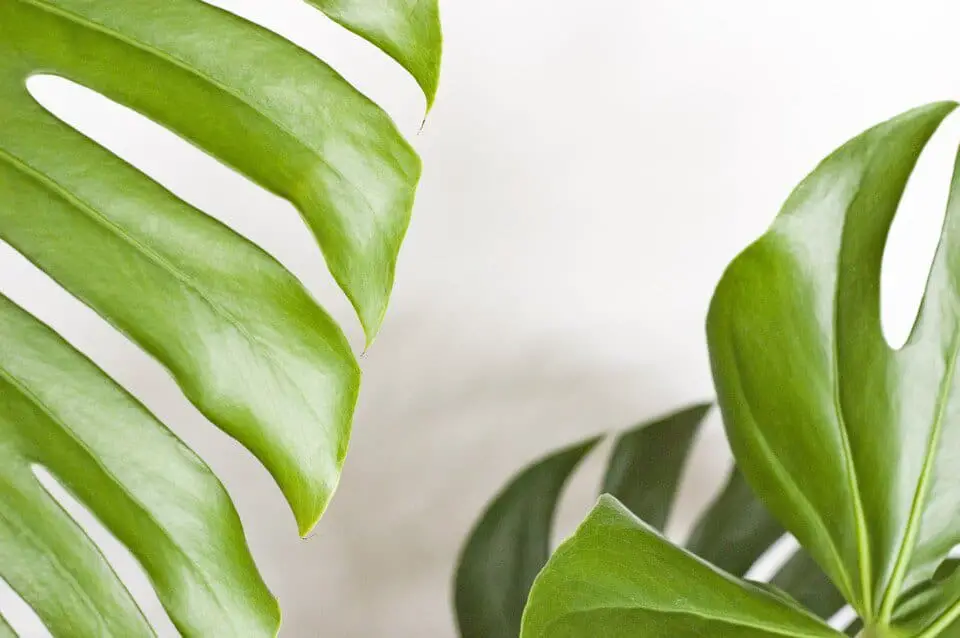Some links in the post are affiliate links and I get a commission from purchases made through some links found in the post.
Are you curious to know why is your Monstera leaves turning yellow?
If you notice the new leaves on your Monstera leaves turning yellow, there is likely an issue with the conditions in which it is being grown.
However, it is normal for older leaves on a Monstera plant to turn yellow as the plant ages.
It is perfectly normal and a positive indication that the plant is directing its energy in the right direction. In the direction of the new growth, which shouldn’t be turning yellow before its time.
There are a lot of folks who don’t understand why the leaves on their Monstera plants are changing color to yellow.
Moreover, there is a wide variety of potential causes for this to occur; however, you must be aware of them to keep your plant alive.
The following are some of the most common factors that contribute to the discoloration of leaves, as well as some potential remedies to these issues.
Main Reasons for Monstera Leaves Turning Yellow
Other than aging, the primary factors contributing to the Monstera leaves turning yellow are:
- Underwatering
- Overwatering
- Conditions with insufficient light
- Pests
- Fungal Diseases
- Shock Due to Transplantation
- Temperature and Humidity
- Over-fertilization
The following are the primary contributors to yellowing of the leaves on your Monstera plant, as well as solutions to the problem.
Underwatering:
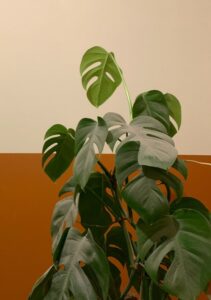 If your Monstera plant gets too little water, the Monstera leaves turn yellow. To your relief, this problem is not only very simple to fix but also poses a much lower risk of causing the death of your plant.
If your Monstera plant gets too little water, the Monstera leaves turn yellow. To your relief, this problem is not only very simple to fix but also poses a much lower risk of causing the death of your plant.
If you stick your finger in the soil, pull it out, and find that the soil is dry, then it is likely that your Monstera plant requires some additional watering.
If you allow your Monstera Adansonii or Monstera Deliciosa to become submerged in water, the leaves will droop, turn yellow, curl, and eventually become light brown and crispy.
Your plant will need much more water than normal since the potting soil that it is growing in is in an excessively dry condition.
You will need to replant your Monstera somewhere else where you can provide abundant water, such as in the shower or outside with a hose.
If the Monstera plant that you wish to relocate is a huge one, you may want to recruit the help of a friend in order to complete the task.
Overwatering:
If you notice that your Monstera leaves are turning yellow, you first need to check the soil to see if it has too much moisture. You need only stick your finger into the potting soil and remove it afterward.
- Does the soil have a slightly putrid or stale odor to it?
- Is the ground waterlogged?
- Is it wet?
If you answered yes to all of these questions, the Swiss Cheese plant you have is likely suffering from root rot as a result of receiving an excessive amount of water.
If the root rot is indeed the issue, you will be required to repot your plant completely.
In addition, the leaves of a Monstera Adansonii or Deliciosa plant that has received excessive water will become yellow, develop brown spots, and droop.
Additionally, it will take a very long time for the soil to dry out, and there is a possibility that fungus will grow on the topsoil.
Be aware that overwatering can occur when watering too frequently or when the soil has a high capacity to retain water. And not by the quantity of water you pour over it each time you water it.
You need to examine the soil of your Swiss Cheese plant to make sure it has not already absorbed an excessive amount of water before you water the plant.
If the soil does not appear to have a lot of moisture in it, then you should water it until it begins to flow out of the bottom drainage holes in the pot.
Because root rot may rapidly destroy your Monstera plant, it is vital to check for this illness before conducting any maintenance or care, and particularly before watering it, as this might make the issue worse.
Checking for this disease should be done before performing any maintenance or care.
Conditions with Insufficient Light:
Every plant requires light to flourish and stay healthy as it grows. Some to a greater extent than others. Bright light tends to bother the Monstera plant quite a bit.
Even though it performs very well in low-light conditions, it might benefit from exposure to a little additional light. The yellowing of the leaves on Monstera plants may indicate that they are not receiving sufficient light.
If there is not enough light, the leaves won’t be able to grow large enough to split, and they may instead keep their more compact heart shapes.
When yellowing occurs on a leaf, it most often occurs along the veins or in localized patches rather than across the entire leaf.
In most cases, east and west-facing windows (depending on your location) provide Monstera with adequate light.
The windows that face north receive the least amount of sunlight, while those that face south will have too much direct sunlight for a Monstera, increasing the risk of leaf burn.
If you have the opportunity, try relocating your plant to a window that faces either the east or the west. If there isn’t enough natural light available, you may utilize artificial light instead.
The lights don’t even need to grow. It’s possible that a steady light fitting with a grow bulb in it will be adequate, and doing so will save money.
Consider using fluorescent lighting if you can’t find any other natural light source. The majority of the lighting options for kitchen cabinets are fluorescent light tube systems.
Some of them are LEDs. Because they generate so little heat, fluorescent and LED lighting are good options for lighting Monstera plants.
Types of Pest
When only certain areas of your Monstera leaves turn yellow there is a good chance that insects or other pests are eating it.
1) Scaly Insects
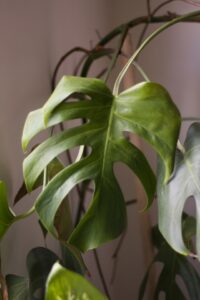 Scales can have a soft body or be armored with a hard shell-like some other types of scales.
Scales can have a soft body or be armored with a hard shell-like some other types of scales.
Both are resilient, and it doesn’t matter how hard you try; they will find a way to attach themselves to virtually any houseplant. There are no exceptions made for Monstera.
When scales are present, you’ll notice that the leaves are covered in teeny brown bumps here and there.
It is possible to remove them by hand, but a more effective method would be to use a Q-tip dipped in rubbing alcohol and apply it to the affected area.
2) Spider Mites
Spider mites are notoriously difficult to detect. At first glance, they appear to be a collection of very small brown dots randomly distributed across the underside of your plant’s leaves.
However, if you keep looking for a significant amount of time, you will eventually notice that they are moving.
Spider mites are typically found on the underside of leaves, where they feed on the sap and excrete honeydew, a sticky substance that can coat the leaves to the point that it prevents light from being absorbed by the leaves, resulting in chlorosis.
Spider mites can also be found on the upper surface of leaves, where they feed on the sap and excrete honeydew.
3) Aphids and Ants
Aphids are a common pest found on many houseplants, and while they can be treated in the same way as most household plant pests, one additional pest that should be mentioned that all too frequently goes unnoticed. The termite.
Because of the complementary ways they obtain food, aphids and ants maintain mutually beneficial relationships.
Aphids, which feed on the sap of plants and excrete honeydew, are the primary source of food for ants, which feed on honeydew.
Types of Fungal Disease
Several different fungal diseases can cause the yellowing of monsteras.
1) Powdery Mildew
Powdery mildew can be brought on by a lack of air circulation, insufficient light, excessive fertilization, or excessive humidity.
Because grouping tropical plants grown indoors can effectively increase the humidity in the air around them, you need to be careful not to group too many of them.
There is a delicate line between grouping your plants and over-stuffing them into space. In most cases, this is when humidity levels can reach dangerously high levels, which can lead to the growth of fungi.
2) Root Rot
When you don’t use a potting mix that drains well, repeatedly submerge your plant in water, or doesn’t aerate the soil occasionally, you run the risk of causing root rot in your plant.
If the water cannot freely drain from the soil, the plant’s roots will become trapped in the wet soil, where they will be deprived of oxygen, which will eventually cause them to suffocate.
After some time, the roots will turn black, and the plant will pass away.
When you have reason to believe that the roots are having difficulty, remove the plant from the pot so that you can examine the roots. Roots that have gone bad will be black, mushy to the touch, and have a putrid odor.
Shock Due to Transplantation
You may have caused your Monstera plant to experience “transplant stress” if you’ve just recently repotted it and its leaves have begun to turn yellow.
Several potential causes of stress in plants include transplanting the plant at the incorrect time of year, moving the plant to a different soil type, root damage, or an incorrect soil pH.
It’s also possible for a plant to become stressed out if the temperature drops significantly, especially if the roots are left exposed for too long before being replanted or moved quickly to a new location.
Alterations in their surrounding environment may have an effect on some plant species.
As a consequence of this, the plant may need some time to recover and readjust to the new environment.
In the meantime, you can take care of the plant by ensuring it has adequate drainage and water, moving it to where it was before, or removing any dead leaves that have accumulated.
Temperature and Humidity
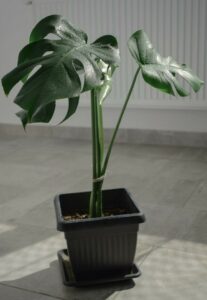 There is a possibility that the temperature or humidity level in your home is not suitable for the type of houseplant that you have.
There is a possibility that the temperature or humidity level in your home is not suitable for the type of houseplant that you have.
Yellowing leaves on a monstera plant can also be caused by low humidity and high temperatures because monsteras are tropical plants.
The tips of the leaves will be the first part of the leaf to change color due to a loss of humidity, but gradually the whole leaf will turn yellow.
To raise the relative humidity around the plant, mist the leaves of the plant with water regularly or position a tray of stones in the water beneath the plant’s container.
Your Monstera’s leaves turning yellow because they have been damaged by the recent high temperatures and rapid temperature shifts.
Put your plant in a warm or ideal spot with tropical temperatures, preferably one that is between 65 and 80 degrees Fahrenheit (18 and 27 degrees Celsius).
You must position your plant in an area free from dry heat vents and cold draughts at all times.
Over Fertilization
If you want your Monstera to remain robust and healthy throughout the growing season, it is in your best interest to feed it every few weeks. The ideal fertilizer for monsteras is complete and balanced.
When the soil becomes saturated with excessive nutrient salts, this condition is known as overfertilization. A process known as reverse osmosis will take place as a result of these, which will draw water away from the plant’s roots.
They are also able to change the acidity of the soil. Salt burn is the result of chemical dehydration, which can be caused when there is excessive salt in the soil.
Is the yellowing of the leaves on your Monstera plant due to an excess fertilizer? Keep an eye out for the following additional signs of overfertilization:
- A crust of excess fertilizer that is white on top of the soil, Edges of leaves that are turning brown and crispy
- The oldest and most distant leaves turn yellow first.
- Slow growth
Fixing the problem of overfertilization is simple.
As soon as you have concluded that this is causing the yellowing of the Monstera leaves, you will need to give the plant a thorough watering to flush all of the excess nutrient salts from the soil.
Potting Container
Monstera plants require a container that has holes in it for water drainage at all times. Drainage holes prevent waterlogging and soggy conditions, resulting in yellowing of the leaves and root rot. Drainage holes also prevent flooding.
The size of the pot is another factor that should be taken into consideration.
When you use a container that is too large for the plant you are growing, there will be insufficient room in the pot for the roots to fill, which will result in root rot because the excess soil will remain damp.
The Monstera Age
There are some instances in which a yellow leaf is not the result of environmental conditions, pests, or diseases. Like any other plant, the Monstera plant will eventually develop yellow leaves as a natural part of its growth.
It is possible for an older leaf, typically a lower leaf, to turn yellow and then fall off on its own. If this is the case, there is no need to be alarmed because this is a normal part of the plant’s life cycle.
The Seasons
Indirectly causing yellowing of the Monstera plant’s leaves can also be the seasons and other environmental factors.
For instance, during the winter months, the soil takes longer to dry out, and as a direct consequence of this, the plant is more susceptible to becoming overwatered.
Alterations in temperature, which are also brought on by the changing of the seasons, can contribute to the yellowing of leaves.
To prevent further yellowing, you should strive to keep the conditions inside your home as stable as possible.
Final Thoughts
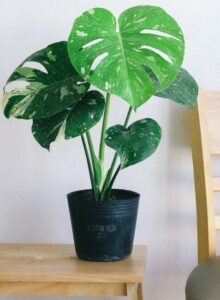 One of the most common houseplant issues is Monstera leaves turning yellow.
One of the most common houseplant issues is Monstera leaves turning yellow.
Fixing the issue is not difficult because it is typically brought on by improper care or unfavorable growing conditions.
Maintain a close eye on your plants and look for early warning signs and symptoms, such as leaves turning yellow.
If you notice any problems with your Monstera’s care early on, you can help it recover more quickly and maintain a higher level of health.

